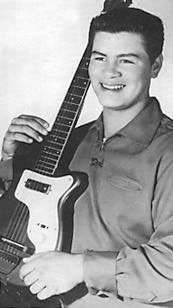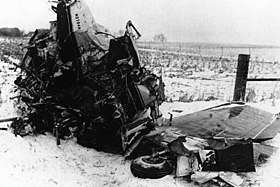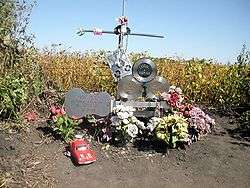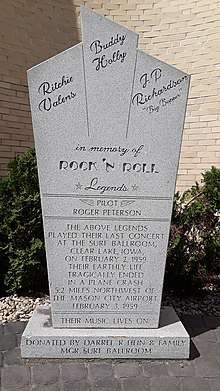Ritchie Valens
Richard Steven Valenzuela (May 13, 1941 – February 3, 1959), known professionally as Ritchie Valens, was an American singer, songwriter, and guitarist. A rock and roll pioneer and a forefather of the Chicano rock movement, Valens was killed in a plane crash eight months into his recording career.[3]
Ritchie Valens | |
|---|---|
 | |
| Background information | |
| Birth name | Richard Steven Valenzuela |
| Also known as | Ritchie Valens[1][2] |
| Born | May 13, 1941 Pacoima, California, U.S. |
| Died | February 3, 1959 (aged 17) Clear Lake, Iowa, U.S. |
| Genres | |
| Occupation(s) |
|
| Instruments | |
| Years active | 1957–1959 |
| Website | ritchievalens |

Valens had several hits, most notably "La Bamba", which he had adapted from a Mexican folk song. Valens transformed the song into one with a rock rhythm and beat, and it became a hit in 1958,[4][5] making Valens a pioneer of the Spanish-speaking rock and roll movement. He also had an American number 2 hit with ''Donna''.
On February 3, 1959, on what has become known as "The Day the Music Died", Valens died in a plane crash in Iowa, an accident that also claimed the lives of fellow musicians Buddy Holly and J. P. "The Big Bopper" Richardson, as well as pilot Roger Peterson. In 2001, Valens was inducted into the Rock and Roll Hall of Fame.
Early life
Valens was born Richard Steven Valenzuela in Pacoima, a neighborhood in the San Fernando Valley region of Los Angeles. His parents, Joseph Steven Valenzuela (1896-1952) and Concepcion "Concha" Reyes (1915-1987), were from Mexico. He was the second of five siblings with older brother Bob Morales, younger sisters Connie and Irma, and younger brother Mario Ramirez.
Valenzuela was brought up hearing traditional Mexican mariachi music, as well as flamenco guitar,[6] R&B, and jump blues. Valenzuela expressed an interest in making music of his own by the age of five. He was encouraged by his father to take up guitar and trumpet, and later taught himself the drums. Though Valenzuela was left-handed, he was so eager to learn the guitar that he mastered the traditional right-handed version of the instrument.
By the time Valenzuela was attending junior high school, he would bring his guitar to school and sing and play songs to his friends on the bleachers.[7] When he was 16 years old, he was invited to join a local band, The Silhouettes (not the group famous for its hit song "Get a Job"). He began as a guitarist, and when the main vocalist left the group, Valenzuela assumed the position. On October 19, 1957, he made his performing debut with The Silhouettes.
Valenzuela attended Pacoima Junior High School (now Pacoima Middle School) and San Fernando High School.[8]
Career
A self-taught musician, Valenzuela was an accomplished singer and guitarist. At his appearances, he often improvised new lyrics and added new riffs to popular songs while he was playing.
Bob Keane, the owner and president of small record label Del-Fi Records in Hollywood, was given a tip in May 1958 by San Fernando High School student Doug Macchia about a young performer from Pacoima by the name of Richard Valenzuela. Kids knew the performer as "the Little Richard of San Fernando". Swayed by the Little Richard comparison, Keane went to see Valenzuela play a Saturday morning matinée at a movie theater in San Fernando. Impressed by the performance, he invited the youth to audition at his home in the Silver Lake area of Los Angeles, where he had a small recording studio in his basement. His recording equipment comprised an early stereo recorder (a two-track Ampex 601-2 portable) and a pair of Neumann U-47 condenser microphones.
After this first audition, Keane signed Valenzuela to Del-Fi on May 27, 1958. At this point, the musician took the name "Ritchie" because, as Keane said, "There were a bunch of 'Richards' around at that time, and I wanted it to be different." Similarly, Keane recommended shortening his surname to "Valens" from Valenzuela to widen his appeal beyond any obvious ethnic group.[9]
Valens demonstrated several songs in Keane's studio that he later recorded at Gold Star Studios in Hollywood. The demos primarily consisted of Valens singing and playing guitar, but some of them also featured drums. These originals can be heard on the Del-Fi album, Ritchie Valens – The Lost Tapes. Two of the tracks laid down in Keane's studio were taken to Gold Star Studios and had additional instruments dubbed over to create full-band recordings. "Donna" was one track (although two other preliminary versions of the song were made, both available on The Lost Tapes), and the other was an instrumental entitled "Ritchie's Blues".
After several songwriting and demonstration recording sessions with Keane in his basement studio, Keane decided that Valens was ready to enter the studio with a full band backing him. The musicians included René Hall, Carol Kaye, and Earl Palmer. The first songs recorded at Gold Star Studios, at a single studio session one afternoon in July 1958, were "Come On, Let's Go", an original (credited to Valens/Kuhn, Keane's real name), and "Framed", a Leiber and Stoller tune. Pressed and released within days of the recording session, the record was a success. Valens's next record, a double A-side, the final record to be released in his lifetime, had the song "Donna" (written about a real girlfriend Donna Ludwig[10]) coupled with "La Bamba". It sold over one million copies, and was awarded a gold disc by the RIAA.[11]
By the autumn of 1958, the demands of Valens' career forced him to drop out of high school. Keane booked appearances at venues across the United States and performances on television programs. Valens had a fear of flying due to a freak accident at his junior high school when, on January 31, 1957, two airplanes collided over the playground, killing or injuring several of his friends.[12] Valens had been at his grandfather Frank Reyes' funeral that day, but was upset about the loss of his friends.
He eventually overcame his fear enough to travel by airplane for his career. He went to Philadelphia to appear on Dick Clark's American Bandstand television show on October 6, where he sang "Come On, Let's Go". In November, Valens flew to Hawaii, where he performed alongside Buddy Holly and Paul Anka. Valens was added to the bill of legendary disc jockey Alan Freed's Christmas Jubilee in New York City, singing with some of those who had greatly influenced his music, including Chuck Berry, Bo Diddley, the Everly Brothers, Duane Eddy, Eddie Cochran, and Jackie Wilson. On December 27, he returned to Philadelphia and American Bandstand, this time performing "Donna".
After returning to Los Angeles, Valens filmed an appearance in Alan Freed's movie Go, Johnny, Go! In the film, he appears in a diner miming his song "Ooh! My Head", using a Gretsch 6120 guitar, the same model Eddie Cochran owned. Between the live appearances, Valens returned to Gold Star Studios several times, recording the tracks that would comprise his two albums.
In early 1959, Valens was traveling the Midwest on a multiple-act rock-and-roll tour dubbed "The Winter Dance Party". Accompanying him were Buddy Holly, Dion and the Belmonts, J. P. "The Big Bopper" Richardson and Frankie Sardo. All performers were augmented by Holly's new backup band, including Tommy Allsup on guitar, Waylon Jennings on bass, and Carl Bunch on drums.
Conditions on the tour buses were abysmal and bitterly cold. Midwest weather took its toll on the party. Carl Bunch had to be hospitalized with severely frostbitten feet, and several others, including Valens and the Big Bopper, caught the flu. The show was split into two acts, with Valens closing the first act. After Bunch was hospitalized, Carlo Mastrangelo of the Belmonts took over the drumming duties. When Dion and the Belmonts were performing, the drum seat was taken by either Valens or Buddy Holly. A surviving color photograph shows Valens at the drum kit. Black and white photos found in 2014 taken by Mary Gerber on February 2, 1959, which are on display at the Surf Ballroom show Buddy Holly playing drums for Dion as Dion's drummer had frostbitten feet.
Death
After the February 2, 1959, performance in Clear Lake, Iowa (which ended around midnight), Holly, Richardson, and Valens flew out of the Mason City airport in a small plane that Holly had chartered. Valens was on the plane because he won a coin toss with Holly's backup guitarist Tommy Allsup. Holly's bassist, Waylon Jennings, voluntarily gave up his seat on the plane to J.P. Richardson, who was ill with the flu.[13] At approximately 12:55 am on February 3, 1959, the three-passenger Beechcraft Bonanza departed for Fargo, North Dakota, and crashed a few minutes after takeoff for reasons still unknown. The crash killed all three passengers and pilot Roger Peterson instantly upon impact. As with Holly and Richardson, Valens suffered massive and unsurvivable head injuries along with blunt force trauma to the chest. At just 17 years old, Valens was the youngest to die in the crash.
The tragedy inspired singer Don McLean to write his 1971 hit "American Pie", immortalizing February 3 as "The Day the Music Died". Valens's remains were buried at San Fernando Mission Cemetery, Mission Hills, Los Angeles, California.
Legacy

Valens was a pioneer of Chicano rock and Latin rock and inspired many musicians of Mexican heritage. He influenced the likes of Los Lobos, Los Lonely Boys, and Carlos Santana, as he had become nationally successful at a time when very few Latinos were in American rock and pop music. He is considered the first Latino to successfully cross over into mainstream rock.
"La Bamba" proved to be his most influential recording, not only by becoming a pop chart hit sung entirely in Spanish, but also because of its successful blending of traditional Latin American music with rock. Valens was the first to capitalize on this formula, which was later adopted by such varied artists as Selena, Caifanes, Café Tacuba, Circo, El Gran Silencio, Aterciopelados, Gustavo Santaolalla, and many others in the Latin alternative scene. Ironically, the Valenzuela family spoke only English at home, and he knew very little Spanish. Valens learned the lyrics phonetically to record "La Bamba" in Spanish. In 2019, the Valens version of "La Bamba" was selected by the U.S. Library of Congress for preservation in the National Recording Registry as "culturally, historically, and aesthetically significant".[14][15]
"Come On, Let's Go" has been recorded by Los Lobos, the Ramones and the Paley Brothers (the Ramones on guitar, bass and drums and the Paley Brothers on vocals), Tommy Steele, the Huntingtons, Girl in a Coma, and the McCoys. Johnny Rebb and his Rebels recorded the song for Leedon/Canetoad Records in Australia. "Donna" has been recorded by artists as diverse as MxPx, Marty Wilde, the Youngbloods, Clem Snide, Cappadonna, and Misfits.
Robert Quine has cited Valens' guitar playing as an early influence on his style. Valens also inspired Jimi Hendrix, Chan Romero, Carlos Santana, Chris Montez, and Keith O'Conner Murphy, among others.
Valens' mother, Connie, who died in 1987, is buried alongside him.[16]
Representation in other media
- Valens has been the subject of several biopic films, including the 1987 film La Bamba. Primarily set in 1957–1959, it depicted Valens from age 16 to 17. It introduced Lou Diamond Phillips as Valens. Los Lobos performed most of the music in the film.
- Valens was portrayed by Gilbert Melgar in the final scene of The Buddy Holly Story.
- He was also featured in the film The Day the Music Died (2010).
- Valens was portrayed by Joseph Thornhill in the 2011 film Lives and Deaths of the Poets.
- The novelization by Ron De Christiforo of the film Grease (1978) is set around the time of Valens' death. In one of the earlier chapters, the gang sits around in Sonny's basement, upset at the death of some of their favorite stars in the plane crash.
- Lil' Libros has an upcoming book based on Valens' life.[17] (2019)
Tributes


In 1989, Ken Paquette, a Wisconsin fan of the 1950s era, erected a stainless-steel monument depicting a guitar and a set of three records bearing the names of each of the three performers killed in the accident. It is located on private farmland, about one-quarter-mile west of the intersection of 315th Street and Gull Avenue, about 8 miles (13 km) north of Clear Lake. He also created a similar stainless-steel monument to the three musicians that was installed near the Riverside Ballroom in Green Bay, Wisconsin. That memorial was unveiled on July 17, 2003.[18]
Paxton Park in Pacoima was renamed in memory of Valens in the 1990s. A city council member representing Pacoima proposed the renaming to honor Valens so residents would "remember his humble background and emulate his accomplishments."[19]
Musician Tommy Allsup started a club, "Tommy's Heads Up Saloon", in Dallas in 1979. The club was named for the fateful coin toss between Valens and him twenty years prior.[20]
"Boogie with Stu" from Led Zeppelin's Physical Graffiti album was inspired by Valens' song "Ooh, My Head". It did not credit Valens or Bob Keane, instead crediting Valens' mother. Eventually, a lawsuit was filed by Keane, and half of the award went to Valens' mother, although she was not part of the suit.[21]
On May 11, 1990, 31 years after his death, Valens was finally honored. A star bearing his name was unveiled on the Hollywood walk of fame. The star cost $3,500, which was paid for with money raised in his name by family and friends. His star permanently resides at 6733 Hollywood Boulevard in front of Artisan's Patio mini mall.[22]
On February 2, 2009, Surf Ballroom held a 50th anniversary honoring the last concert of Buddy Holly, J.P. "The Big Bopper" Richardson, and Valens. The event lasted one week and had performances that honored the memories of the three men. Family members and friends of the stars made appearances. Their legacies live on through events such as these.[23]
Many murals have been painted around Pacoima in honor of the late Valens. In 1985, artist Manuel Velasquez (assisted by 25 students) created a 12-foot by 20-foot mural which was painted on the side of a classroom building at the former Pacoima Junior High (now Pacoima Middle School) depicting Valens's image, records labeled with some of his greatest hits, as well as the newspaper article about the plane crash that took his life.[24] Another mural went up in 2012 at the intersection of Van Nuys Boulevard and Amboy Avenue and was painted by Hector Ponce. A second one was painted in 2012 by Levi Ponce and is located on Van Nuys Boulevard and Telfair Avenue. A monument has also been built as a tribute. It was put on display in 2013 and is located at Ritchie Valens Park at 10731 Laurel Canyon Boulevard.[25]
A section of the 5 Freeway in the northeast San Fernando Valley has been named after Valens. The Ritchie Valens Memorial Highway is located between the 170 and 118 freeways.[26] On Saturday August 25, 2018, a celebration was held in his honor to commemorate his legacy. The unveiling ceremony was held at Ritchie Valens Park, located at 10731 Laurel Canyon Boulevard in Pacoima. Replicas of the freeway sign were revealed at the celebration. The event was open to the public and free to attend. A few relatives of Valens played live performances as a tribute to the late singer. Leaders from the community and state gathered for the festivities.[27]
Discography
Original albums
- Ritchie Valens (March 1959) – Del-Fi DFLP-1201 (US #23)
- Ritchie (October 1959) – Del-Fi DFLP-1206
- In Concert at Pacoima Jr. High (December 1960) – Del-Fi DFLP-1214
- Side 1 features the concert with opening narrative by Bob Keane, side 2 features five unfinished tracks as described by Keane. "Come On, Let's Go" on side 1 is a demo version with the concert noise dubbed in.
Compilation albums
- Ritchie Valens Memorial Album (December 1962) – Del-Fi DLFP-1225
- Originally released with black cover, reissued in February 1963 with different cover (in white) and retitled His Greatest Hits
- Ritchie Valens...His Greatest Hits Volume 2 (1964) – Del-Fi DFLP-1247
- History of Ritchie Valens (1981) – Rhino Entertainment RNBC-2798
- Box set replicating the three original albums plus booklet
- The Best of Ritchie Valens (1987) – Rhino Entertainment 70178 (US #100)
- La Bamba '87 (1987) – Del-Fi DF-1287
- 12" EP featuring four different mixes of La Bamba
- The Ritchie Valens Story (1993) – Rhino Entertainment/ Del-Fi 71414
- Featuring hits, outtakes, rare photos, and a 20-minute narrative of Valens by manager Bob Keane
- Rockin' All Night - The Very Best of Ritchie Valens (1995) – Del-Fi DFCD-9001
- Come On, Let's Go! (1998) – Del-Fi DFBX-2359
- Deluxe 3-CD, 62-track set featuring all tracks from the three original albums plus rare demos and outtakes. 62-page booklet features biography and rare photos. Package also comes with poster, picture cards, and Rock & Roll Hall of Fame campaign cards
- The Very Best of Ritchie Valens (1999) – Repertoire Records RT-4217
- La Bamba – The Definitive Collection (2011) – One Day Music DAY2CD104
- This CD consists of all three albums original albums plus a promo track ('Spoken promo for Winter Dance Party).
- Other releases (The Complete Ritchie Valens, Jasmine, 2012; The Complete Releases 1958–1960, Acrobat, 2019; The Essential Recordings, Primo, 2017) contain the same material but omit the promo track. The Essential Recordings omits Bob Keane's spoken introductions.
Singles
| Year | Titles (b/w indicates B-side track) Both sides from same album except where indicated |
Record label | Peak chart positions | Album | |
|---|---|---|---|---|---|
| US Billboard | US Cashbox | ||||
| 1958 | "Come On, Let's Go" b/w "Framed" |
Del-Fi 4106 | 42 | 51 | Ritchie Valens |
| "Donna" b/w "La Bamba" |
Del-Fi 4110 | 2 22 |
2 49 | ||
| 1959 | "Fast Freight" b/w "Big Baby Blues" Original pressings shown as "Arvee Allens"; later pressings shown as "Ritchie Valens" |
Del-Fi 4111 | - | - | Ritchie |
| "That's My Little Suzie" b/w "In A Turkish Town" |
Del-Fi 4114 | 55 | 43 | Ritchie Valens | |
| "Little Girl" b/w "We Belong Together" (from Ritchie Valens) |
Del-Fi 4117 | 92 | 93 | Ritchie | |
| "Stay Beside Me" b/w "Big Baby Blues" |
Del-Fi 4128 | - | - | ||
| 1960 | "The Paddiwack Song" b/w "Cry, Cry, Cry" The above three singles were issued on gold Valens Memorial Series labels. Del-Fi 4117 was also issued with picture sleeve. |
Del-Fi 4133 | - | - | |
| 1987 | "La Bamba '87" b/w "La Bamba" (original version from Ritchie Valens) |
Del-Fi 1287 | - | - | Non-album track |
| 1998 | "Come On, Let's Go" b/w "La Bamba" |
Del-Fi 51341 | - | - | Come On, Let's Go! |
See also
References
- "Arvee Allens – Big Baby Blues / Fast Freight". Discogs.com. Retrieved 26 October 2017.
- "Del-Fi Album Discography". Bsnpubs.com. Retrieved 26 October 2017.
- "Ritchie Valens - the Pioneer of Rock and Roll". EF News International. December 16, 2011. Archived from the original on February 6, 2012.
- Letivan, Corey (July 5, 2005). "Latino rockers no longer lost in translation". Daily Breeze. Archived from the original on September 28, 2007.
- "TEMAS | Rock en Venezuela" (in Spanish). Mipunto.com. Archived from the original on February 13, 2012. Retrieved September 12, 2013.
- City News Service (13 May 2016). "LA declares Ritchie Valens Day on 75th anniversary of his birth". Los Angeles Daily News (LDN). Los Angeles Daily News (LDN). Retrieved 25 November 2018.
- Bob Keane (October 6, 2006). The Oracle of Del-Fi. Del-Fi International Books. ISBN 978-0976810513.
- "San Fernando High School Alums | i am san fernando". iamsanfernando.com. Retrieved 7 February 2018.
- "Valens, Ritchie." Encyclopedia of Popular Music, 4th ed. Ed. Colin Larkin. Oxford Music Online. Oxford University Press. Web. 15 Feb. 2016.
- McIntosh, Barbara (September 4, 1987). "The Reveries of Valens' Donna". The Washington Post. Retrieved May 30, 2020.
- Murrells, Joseph (1978). The Book of Golden Discs (2nd ed.). London: Barrie and Jenkins Ltd. p. 108. ISBN 0-214-20512-6.
- "The Pacoima Plane Crash". Angiejim.homestead.com. January 31, 1957. Retrieved September 12, 2013.
- Lehmer, Larry. The Day the Music Died: The Last Tour of Buddy Holly, the Big Bopper and Ritchie Valens, Omnibus Press (April 1, 2004), ch. 8.
- Andrews, Travis M. (March 20, 2019). "Jay-Z, a speech by Sen. Robert F. Kennedy and 'Schoolhouse Rock!' among recordings deemed classics by Library of Congress". The Washington Post. Retrieved March 25, 2019.
- "Ritchie Valens' 'La Bamba' Inducted Into National Recording Registry of the Library of Congress". Billboard.
- Wilson, Scott (2016). Resting Places: The Burial Sites of More Than 14,000 Famous Persons (3rd ed.). McFarland. p. 766. ISBN 9781476625997.
- The Life of - La Vida de Ritchie. ASIN 1947971352.
- Jordan, Jennifer (April 11, 2007). "The Day the Music Died". ArticlesTree. Archived from the original on February 7, 2012.
- "Ritchie Valens Park". City of Los Angeles Department of Recreation & Parks. Retrieved September 12, 2013.
- Larry Lehmer (2004). The Day the Music Died: The Last Tour of Buddy Holly, the Big Bopper, and Ritchie Valens. Music Sales Group. ISBN 978-0-8256-7287-3.
- Lehmer, Larry. The Day the Music Died: The Last Tour of Buddy Holly, the Big Bopper and Ritchie Valens (2004): 166.
- Starr Spencer (1990). "Ritchie Valens Finally Gets His Star". Chicago Tribune.
- PR Newswire (2008). "Rock and Roll Hall of Fame and Museum and Surf Ballroom & Museum to Honor 50 Year Anniversary of Winter Dance Party". PR Newswire Association.
- "Richie Valens – Mural Conservancy of Los Angeles". Muralconservancy.org. Retrieved 26 October 2017.
- Dalia Espinosa (2018). "Pacoima is ready to celebrate The Ritchie Valens Memorial Highway in one more reminder of the late Chicano rocker's legacy". Los Angeles Daily News.
- Patrick McGreevy. "Ritchie Valens, late rock star and local hero, gets a stretch of the 5 Freeway in the Valley named after him". Los Angeles Times.
- Dalia Espinosa (2018). "Pacoima is ready to celebrate The Ritchie Valens Memorial Highway in one more reminder of the late Chicano rocker's legacy". Los Angeles Daily News.
External links
| Wikimedia Commons has media related to Ritchie Valens. |
- Ritchie Valens on IMDb
- Official Ritchie Valens webpage
- "Ritchie Valens". Rock and Roll Hall of Fame.

- RAB Hall of Fame: Ritchie Valens
- Profile, history-of-rock.com
- Profile, tsimon.com
- Tribute: The Day the Music Died, angelfire.com